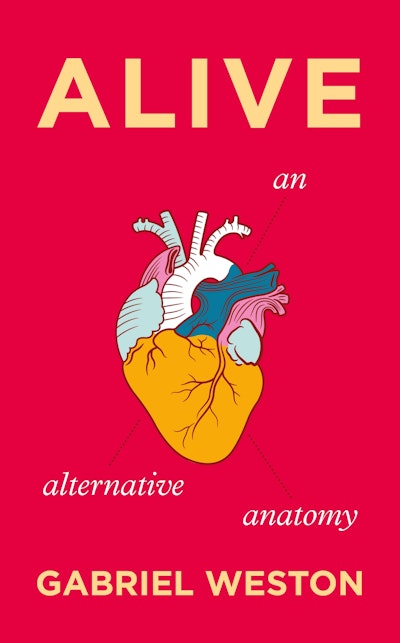 Reviewed by Heather Campbell
Reviewed by Heather Campbell
Alive: Our Bodies and the Richness and Brevity of Existence
by Gabriel Weston
Godine
March 2025, Hardcover, 304pp, $29.95USD, ISBN: 9781567928235
Alive is not for the faint of heart. Not because of the sometimes jarringly graphic descriptions of autopsies, uterine transplants, or steadily pooling blood from a sawn-through femur, but because of the unique perspective it gives us on how our bodies function. When we say we “critically dissect” a subject in the humanities we’re usually being less than literal, but in this case, we really look over the shoulder of an operating surgeon. But what might be most jarring is how the author makes us feel a simple wonder about the bodies we exist inside. I found myself often thinking, how do I not know this about myself? That our bones don’t fully ossify until about age 30. That the health of our gut microbiome can be linked to treatment of depression and anxiety. How significantly the liver can regenerate.
Dr. Gabriel Weston gives us a unique view on anatomy drawn from her background as an English major and award-winning writer, as well as a notable surgeon. Since her path to the operating theatre wasn’t a typical one, she has full licence to produce a book that is far from a typical non-fiction medical text. After receiving her English degree, she worked at a publishing house until she stumbled upon a new program being offered at a London medical school. There, a professor “had developed a hunch. Maybe the usual stock of candidates with perfect science scores weren’t the only ones who would make good doctors.” She enrolled, and a career as a well-respected surgeon followed.
Alive takes us on a tour of the body by chapter, from bones to lungs to kidney to womb. Weston works hard to turn an anatomy tutorial into a story – or perhaps infuse a story with a bit of a tutorial. Each section provides a scientific and historical overview of the organ in question, a personal narrative of a patient, and often a journey into the role of the treating physician.
These patient stories also include the author: woven between the chapters is the story of the author’s own medical crisis, involving mitral valve degeneration. But we are only given a paragraph at a time of this story, making it too easily lost. Perhaps it could have sat more confidently in its entirety in the ‘heart’ chapter, as her son’s medical condition sits within ‘brain’. But it is essential to recognise that the doctor can also be patient; the teacher also student. Just as the subject under study in anatomy is an actual human, the author of a book on the body compellingly inserts her own body into the text.
Weston also weaves a philosophical perspective between the human and the clinical, reflecting that “the way our identity is tethered to our physical being is much more slippery than we might like to imagine,” or relating Heidegger and Sartre to the passage of time for a patient on dialysis. Maybe she is both trying to make her fellow doctors think more holistically (“we are not separable from those we care for,” she writes), and her fellow humans think more medically. But shifting between these different lenses – from the highly technical, to the very human, to the abstract and philosophical – is a balancing act. As mentioned above, in the chapter on the brain, we are given Weston’s son’s story. It’s presented in quick, staccato bursts between a somewhat cursory description of the brain’s unique medical mysteries. This is clearly excusable: the jumps in her son’s story are those of a mother who is freaking out. The fuzziness in the presentation of the brain is that of a doctor who will not presume too much knowledge about an organ not within her primary field of expertise. But this section feels rough by consequence.
There is one other unsettling characteristic of the text. Weston’s many colleagues and experts are almost entirely nameless: we meet a professor at a “big London medical school”; Mr. P and Miss P, both surgeons; Dr. K, who pioneered a major procedure that’s the subject of almost an entire chapter, but who still doesn’t get a name; the “beautiful surgeon” Miss R; and a “handsome Syrian surgeon.” Patient confidentiality is expected, but is there a reason why none of these doctors consented to be identified? If this omission is simply a choice of the author, it creates a lack of authority – perhaps intentional – and a lightweight attitude regarding expertise – perhaps unintentional.
Overall, Alive succeeds in making the physical body a source of wonder, as a warmly and colorfully written anatomical overview, and as a plea for more attention to patients’ overall wellbeing and input. As Dr. Weston writes, “the truth of the body is as much about storytelling as it is about anatomy.” That storytelling perspective on the body also defines her approach to this book, and gives the reader a unique appreciation of living within our very own unique selves.
About the reviewer: Heather Campbell is a Montreal-based poet with publications in Grain, Prairie Fire, CV2, The Capilano Review, and PRISM International. Her reviews have appeared in Grist, the Women’s Post and Dance International Magazine.